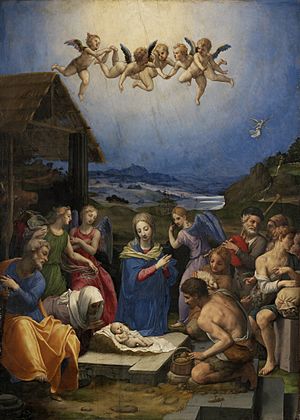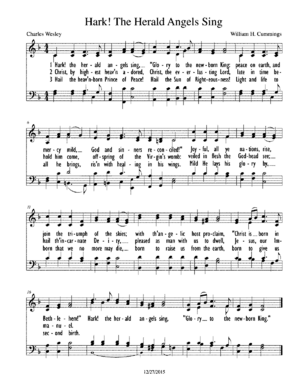Hark! The Herald Angels Sing facts for kids
Quick facts for kids Hark! The Herald Angels Sing |
|
|---|---|

Worship of the Shepherds by Bronzino
|
|
| Genre | Christmas carol |
| Written | 1739 |
| Text | Charles Wesley, adapted by George Whitefield and others |
| Based on | Luke 2:14 |
| Meter | 7.7.7.7 D with refrain |
| Melody | "Festgesang" by Felix Mendelssohn, adapted by William H. Cummings |
"Hark! The Herald Angels Sing" is a famous English Christmas carol. It first appeared in 1739 in a collection called Hymns and Sacred Poems. The song is based on a Bible verse from Luke 2:14, which talks about angels singing praises to God.
The version of the carol we know today has words written by Charles Wesley and George Whitefield. Both were important leaders in the Methodism church. The music comes from a piece called "Vaterland, in deinen Gauen" by Felix Mendelssohn. An English musician named William H. Cummings later changed this music to fit the carol's words.
Charles Wesley first wrote the song as "Hymn for Christmas-Day." He wanted it to be sung slowly and seriously. His original first lines were "Hark! how all the welkin rings / Glory to the King of Kings." Over time, other people changed the words. George Whitefield made the most famous change, giving us the opening lines we sing today.
In 1840, about 100 years after Wesley's hymn was published, Mendelssohn wrote a special song called a cantata. He wrote it to celebrate Johannes Gutenberg's invention of movable type printing. It is music from this cantata that William H. Cummings later adapted for "Hark! The Herald Angels Sing." This is the tune that makes the carol so popular today.
Contents
How the Song's Words Changed Over Time
The original words for "Hark! The Herald Angels Sing" were written by Charles Wesley. He called it a "Hymn for Christmas-Day." It was part of a collection published by John Wesley in 1739. The first part of the hymn describes the angels announcing Jesus' birth.
Wesley's original hymn started with the line "Hark how all the Welkin rings." This was changed by George Whitefield in 1754. Whitefield changed it to the well-known "Hark! the Herald Angels sing."
Another change happened in 1782. In a book called New Version of the Psalms of David, Whitefield's version of Wesley's hymn appeared. This version added the repeating lines "Hark! the Herald Angels sing/ Glory to the newborn king" at the end of each verse. This is how the carol is usually sung today.
Here are some examples of how the words changed:
- Wesley's original first verse began: "HARK how all the Welkin rings / "Glory to the King of Kings, / "Peace on Earth, and Mercy mild, / "GOD and Sinners reconcil'd!"
- Whitefield's version changed it to: "HARK! the Herald Angels sing / Glory to the new-born King! / Peace on Earth, and Mercy mild, / God and Sinners reconcil'd."
- The modern version often adds the repeating chorus: "Hark! The herald-angels sing / "Glory to the newborn king" at the end of each verse.
The Music Behind the Carol
Mendelssohn's Tune
In 1855, a British musician named William Hayman Cummings took music from Felix Mendelssohn's Festgesang. He changed it to fit the words of "Hark! The Herald Angels Sing." Charles Wesley had actually imagined his song being sung to the same tune as his Easter song, "Christ the Lord Is Risen Today."
"Hark! The Herald Angels Sing" became one of the Great Four Anglican Hymns. It was published in a hymn book in 1872.
In Britain, the carol is often sung with a special arrangement. This arrangement keeps William H. Cummings' original music for the first two verses. But for the third verse, it adds a higher singing part (called a soprano descant) and a special organ part. This arrangement was first published in 1961. It is often sung as the last song at the yearly Service of Nine Lessons and Carols at King's College Chapel, Cambridge.
Handel's Tune
Sometimes, the hymn is sung to a different tune. This tune is called "See, the Conqu'ring hero comes." It comes from Handel's opera Judas Maccabaeus. This tune is usually used for the hymn "Thine Be the Glory."
This less common arrangement is traditionally used at the Festival of Nine Lessons and Carols in St Patrick's Cathedral, Dublin. This event is broadcast live on Christmas Eve each year. This version of the carol is quite long, lasting about seven and a half minutes. It includes brass instruments and drums along with the church organ.
See also
 In Spanish: Hark! The herald angels sing para niños
In Spanish: Hark! The herald angels sing para niños


